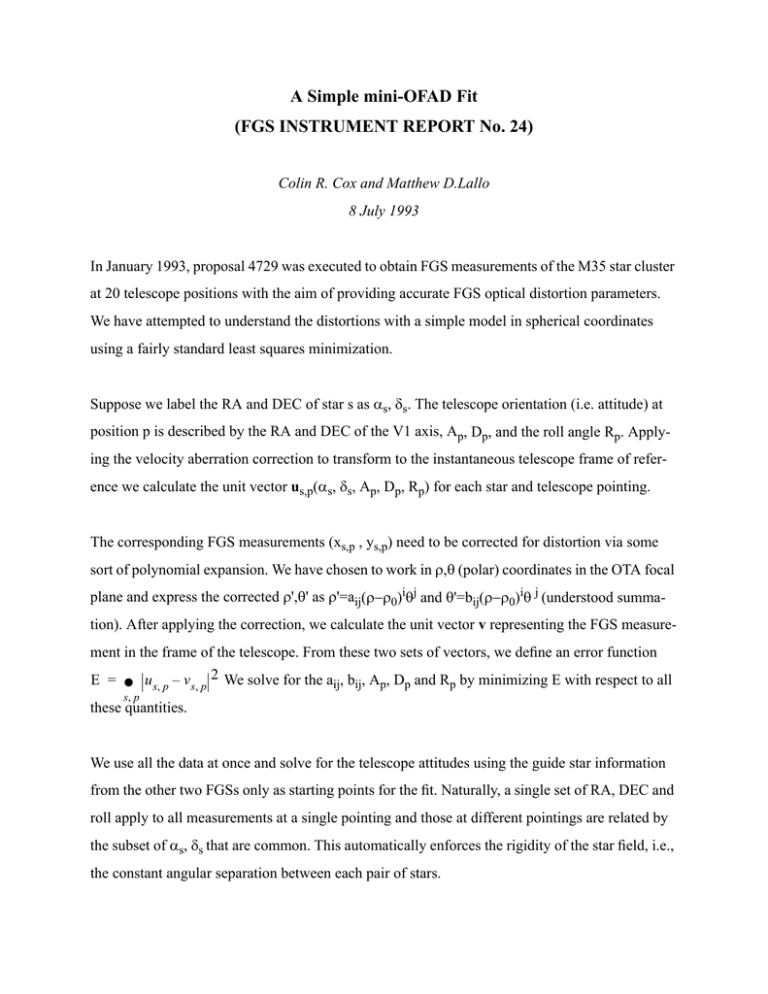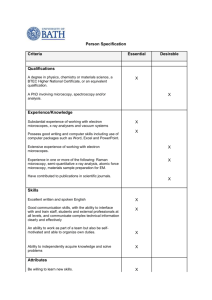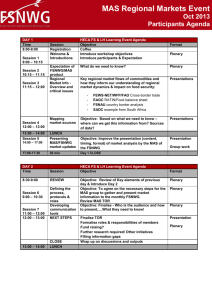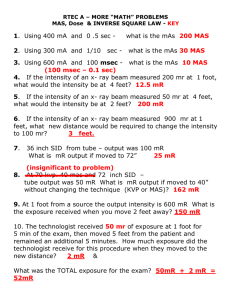A Simple mini-OFAD Fit (FGS INSTRUMENT REPORT No. 24)
advertisement

A Simple mini-OFAD Fit (FGS INSTRUMENT REPORT No. 24) Colin R. Cox and Matthew D.Lallo 8 July 1993 In January 1993, proposal 4729 was executed to obtain FGS measurements of the M35 star cluster at 20 telescope positions with the aim of providing accurate FGS optical distortion parameters. We have attempted to understand the distortions with a simple model in spherical coordinates using a fairly standard least squares minimization. Suppose we label the RA and DEC of star s as αs, δs. The telescope orientation (i.e. attitude) at position p is described by the RA and DEC of the V1 axis, Ap, Dp, and the roll angle Rp. Applying the velocity aberration correction to transform to the instantaneous telescope frame of reference we calculate the unit vector us,p(αs, δs, Ap, Dp, Rp) for each star and telescope pointing. The corresponding FGS measurements (xs,p , ys,p) need to be corrected for distortion via some sort of polynomial expansion. We have chosen to work in ρ,θ (polar) coordinates in the OTA focal plane and express the corrected ρ',θ' as ρ'=aij(ρ−ρ0)iθj and θ'=bij(ρ−ρ0)iθ j (understood summation). After applying the correction, we calculate the unit vector v representing the FGS measurement in the frame of the telescope. From these two sets of vectors, we define an error function E = u – v 2 We solve for the a , b , A , D and R by minimizing E with respect to all ∑ s, p s, p s, p ij ij p p p these quantities. We use all the data at once and solve for the telescope attitudes using the guide star information from the other two FGSs only as starting points for the fit. Naturally, a single set of RA, DEC and roll apply to all measurements at a single pointing and those at different pointings are related by the subset of αs, δs that are common. This automatically enforces the rigidity of the star field, i.e., the constant angular separation between each pair of stars. Certain polynomial coefficients need to be fixed to avoid indeterminacy problems. The only constant term included is ρ0 which makes the two coordinate systems coincident at the center of the FGS field of view. At this position we will say that the distorted and undistorted axes lie over each other. So the a01 and b10 coefficients are held at zero. Without this constraint the roll angles would be indeterminate. Some notes concerning methods We have based our minimization on the variable metric routine DFPMIN from Numerical Recipes. We had to do some editing to allow the routine to fit more than 50 parameters. Ultimately we used 18 orbits. Two orbits suffered from loss of guide star lock, and attitude was controlled on gyros. These 18 orbits, or pointings, contribute 3 parameters each, and 18 coefficients to express the third order fit, making a total of 72 parameters. We were uncertain as to whether a fitting program could find its way through the chi-squared space of so many dimensions, and in fact there remain some problems that might be related to this situation. Note that another Numerical Recipes method. (FRPRMN) failed quite badly when the full set of data was used although it worked well with a small number of pointings. To assist in the hunt for the minimum, we first fit each pointing separately allowing only the scales to change. We use the pointing parameters thus obtained as starting points for the full fit. Then we perform the linear fit and use this solution as the starting point for the second order fit, and so on. We plot out the residuals to guide us at each stage and to see whether the next higher order fit is justified by the data. The linear fit clearly showed the need for higher terms and had an RMS deviation of 0.292'' (292 milli-arcseconds or mas) per star. The second order fit brought this down to around 70 mas but indicated a slope in the plot of ρdθ against ρ. This suggested that there is some dependence of θ on ρ, and that the b10 term is not zero. This corresponds to a tilt of one axis by one part in a thousand or 1/20 degree. Allowing the extra term into the fit reduced the RMS deviation to 54mas and flattened out the residual plot. At the same time it made more clear that a cubic term is required in θ. The fitting program failed to find this term, so we have simply calculated it and incorporated it into the solution, thus reducing the RMS deviation to 33 mas. Since chisquared is thereby reduced by a factor of 2.7 it is surprising that the fitting program did not find this. We will be pursuing this further using routines from Argonne National Laboratory’s Minpack Project. There is no indication from our residuals that any higher order coefficients will improve the fit. As expected the fitting program does not find any non-zero 4th order terms, but, since it failed to find any non-zero third order terms this cannot be considered as a useful indicator. The solution found has an RMS deviation of 33 mas for 442 pairs of measurements and 72 fitting parameters. There are, therefore, 812 degrees of freedom and the RMS error of the fit should be about 1.2 mas. The errors on the coefficients have been estimated by finding what change in each coefficient increases the chi-squared by 1. The effect of the coefficient errors estimated in this way is of the order of a few mas at the edge of the field. We have not as yet estimated the combined effect which would involve sorting out the correlations. Comparing the fitted values of the telescope attitude with those obtained from the guide stars shows no significant displacement in RA and DEC but a roll difference of 0.55 +/- 0.01 degrees in roll. This corresponds to the redefinition of the V2V3 system made in February 1991 which was a 0.5 degree rotation from the original FGS2 based definition. Data Difficulties Clearly we are to some extent limited by the precision of the star catalog which would appear to be about 30 mas. The star positions used are from an M35 catalog based on McNamara’s plates and supplied to us by Barbara McArthur of the ST Astrometry team. Color and magnitude corrections have been applied by Gary Welter of PASS. We compared the positions given in the observation headers to the catalog and used the closest catalog values so long as the positions agreed to within 10 arcsec. In a few cases no close matches were found and we have omitted those measurements. The 10 arcsec limit might seem too loose, but a comparison of the Guide Star Catalog with the McNamara values shows discrepancies of up to 3 or 4 arcsec We include a difference plot to illustrate this. The repeated measurements of some of the stars vary by as much as 20 mas even within the same pointing. We show the observation history of the most frequently measured star which was observed 34 times. This was labelled 4765_52 in the data headers. What is displayed is the difference between the u and v vectors in terms of a change in the RA direction expressed in arcsec. The x-axis is a pointing number. Overall the variation is in the 40 mas range and this incorporates measurement errors plus errors of the fit. Where there are several measurements at the same pointing we still see changes of 10 to 20 mas and this has to be attributed to measurement effect, due perhaps to changes in pointing or focus (i.e. ‘breathing’). The variations can be seen in the raw measurements. We discarded 4 outlier stars in performing the fit. They deviated from the fitted positions by more than 100 mas but were self consistent. since the rest of the catalog seems to be accurate to 30 mas, we suspect some simple typographical error. The errant stars are 4765_11, 4765_27, 4765_73 and 4765_92.





